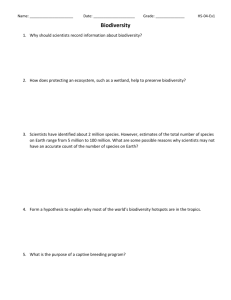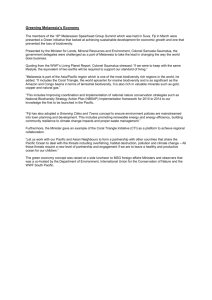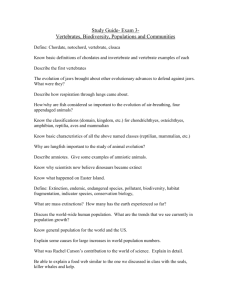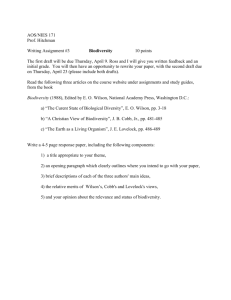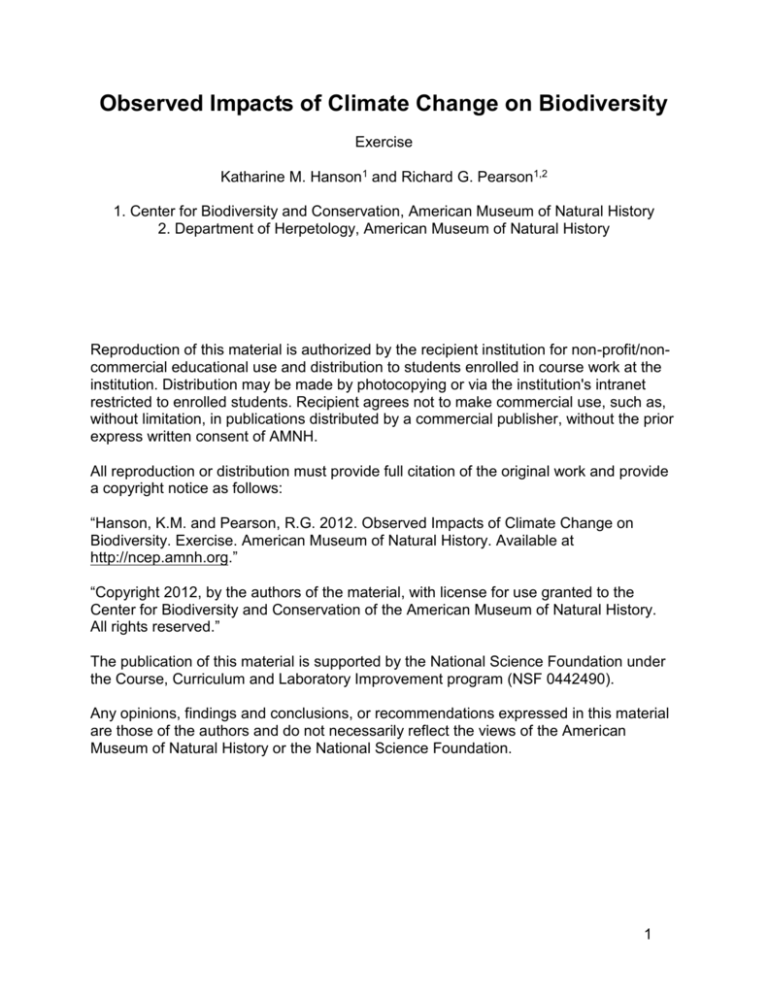
Observed Impacts of Climate Change on Biodiversity
Exercise
Katharine M. Hanson1 and Richard G. Pearson1,2
1. Center for Biodiversity and Conservation, American Museum of Natural History
2. Department of Herpetology, American Museum of Natural History
Reproduction of this material is authorized by the recipient institution for non-profit/noncommercial educational use and distribution to students enrolled in course work at the
institution. Distribution may be made by photocopying or via the institution's intranet
restricted to enrolled students. Recipient agrees not to make commercial use, such as,
without limitation, in publications distributed by a commercial publisher, without the prior
express written consent of AMNH.
All reproduction or distribution must provide full citation of the original work and provide
a copyright notice as follows:
“Hanson, K.M. and Pearson, R.G. 2012. Observed Impacts of Climate Change on
Biodiversity. Exercise. American Museum of Natural History. Available at
http://ncep.amnh.org.”
“Copyright 2012, by the authors of the material, with license for use granted to the
Center for Biodiversity and Conservation of the American Museum of Natural History.
All rights reserved.”
The publication of this material is supported by the National Science Foundation under
the Course, Curriculum and Laboratory Improvement program (NSF 0442490).
Any opinions, findings and conclusions, or recommendations expressed in this material
are those of the authors and do not necessarily reflect the views of the American
Museum of Natural History or the National Science Foundation.
1
Observed Impacts of Climate Change on Biodiversity
Exercise
OVERVIEW
There is strong scientific evidence that climate change is already impacting plant and
animal populations, and model projections indicate that current trends (e.g., poleward
and upslope distribution shifts, extinctions) are likely to continue over the coming
century. Evidence from the fossil record and from recently observed trends
demonstrates that changes in climate can have a profound influence on the myriad of
species that comprise Earth’s biodiversity. A key factor that differentiates contemporary
climate change from past changes is that the present impacts are combined with
multiple other stressors, such as habitat fragmentation, that present simultaneous
challenges to populations and species. Predicted climate change over the coming
century is therefore likely to have a significant influence on biodiversity.
Predictions of continued rapid climate change have prompted many attempts to
estimate future impacts on biodiversity. Various methodological approaches have been
taken to estimate future impacts, including the use of species distribution models to
estimate range shifts as the climate changes. Predictions for some species of extremely
high extinction risk due to climate change have generated a great deal of debate among
scientists, politicians, and the broader general public. Uncertainties inherent in the
predictions, along with debate as to how (if at all) society should manage these threats,
make managing climate change a controversial issue. Despite these uncertainties, there
is an urgent need to make decisions about how society will (or will not) respond to the
threat that climate change poses to biodiversity.
Management options revolve around limiting climate change through reductions in
atmospheric greenhouse gas concentrations, and adapting to changing conditions, for
example by incorporating potential shifts in species’ distributions into the planning of
new natural reserves.
EXERCISE OBJECTIVES
In this exercise, you have two primary objectives:
(1) To examine existing scientific evidence for the impacts of climate change on Earth’s
diversity of living organisms, and
(2) To practice communicating science, specifically climate change science
The focal point of this exercise is a series of in-class interviews between pairs of
students participating as either scientists or journalists (see descriptions of roles below).
2
Additional handouts associated with this exercise will guide you through the preinterview preparation process, a writing assignment, and a post-interview reflection.
PARTICIPANT ROLES
Climate Scientist
You are a leading scientist and have published widely on the topic of climate change
and its impacts on biodiversity. You think it important that scientists should never ‘stray
from the facts’ in order to argue for a course of action and you are careful to emphasize
uncertainty in future predictions when addressing a general audience. You do not want
to compromise your objectivity as a scientist, but you have strong personal opinions that
make you want to advocate for policies to reduce climate change and its impacts on
nature.
You are attending a major scientific conference and presenting a talk on your research.
You have been asked to participate in an evening event that encourages interaction
between scientists and journalists. The focus of the evening is climate change science.
Journalist
You work for a national media outlet, where you are a correspondent for the ‘Science’
section. You want to get behind the science, to interpret results beyond the rather dry
way they are presented in academic journals. You aim to portray science accurately, but
you are also acutely aware that your articles require a catchy headline and some key,
bold statements in order to grab the attention of readers.
You are attending a major scientific conference where the world’s leading climate
scientists will be gathered to present new research. You have been asked to participate
in an evening event that encourages interaction between scientists and journalists. The
focus of the evening is climate change science. Your editor has asked you to attend the
event and write a short article on the topic of climate change and its impacts on plants
and animals.
BACKGROUND INFORMATION
In this exercise and related class discussions, you will explore the following categories
of observed impacts of climate change on biodiversity:
Poleward Distribution Shifts
One of the expected impacts of climate change on biodiversity is a shift in species’
distributions toward the poles (i.e., northward shifts in the northern hemisphere, and
southward shifts in the southern hemisphere). As climates generally get cooler moving
away from the equator, particular climate regimes will be expected to move toward
higher latitudes as global temperatures rise under climate change. Species’ distributions
and range boundaries are often closely coupled with climate regimes and thus are
expected to and have been observed to shift with changes in average temperatures.
3
Upslope Distribution Shifts and Extinction
Because temperature decreases with increased elevation, warming in a mountainous
region causes conditions previously found at lower elevations to move upslope toward
higher elevations. This is the reason why many glaciers on high tropical mountains are
rapidly melting. Various studies examining montane, or mountain-dwelling, amphibians
have documented upslope distribution shifts, meaning that species are now found at
higher elevations than those recorded in previous decades. For montane species, the
potential for extinction exists in cases where the population is unable to move to higher
elevation or adapt to new climatic conditions.
Disease Risk
There is concern that rising temperatures and changed precipitation regimes may favor
certain pathogens, potentially triggering disease outbreaks in species and in areas that
were previously unaffected or affected by only low levels of disease. Changes in the
disease levels are driven by a combination of changes in both the abundance and
distribution of the pathogen species as well as in the abundance, distribution, and health
of the affected host species. Changes in the prevalence and severity of diseases
illustrate the complexity of climate-related changes in natural systems.
Phenological Changes
Phenology is the study of biological life-cycles throughout the year. Examples of
phenological events include egg-laying and migration in birds, flowering and fruiting in
plants, and reproductive periods in frogs. Such events are often closely related to
climate. For example, warming each spring initiates a flurry of biological activity related
to growth and reproduction for many species.
The earlier occurrence of spring events is an expected response to climate change: as
the climate warms, higher temperatures arrive earlier in the year and trigger life cycle
events. Differing phenological responses can result in disruption of ecosystem
interactions, such as birds failing to breed at the time of maximal food abundance.
Coral Bleaching
Coral reefs are one of the most biologically diverse ecosystems on Earth. Almost all
corals live in a symbiotic relationship with zooxanthellae, a type of single celled algae
that lives within the coral’s tissues. Zooxanthellae photosynthesize, and in doing so
produce compounds that are absorbed as a food source by the coral. Bleaching occurs
when this coral-algae relationship breaks down, resulting in the loss of the
zooxanthellae from coral tissues, and consequently a loss of color. Although corals can
survive bleaching events, mortality tends to occur if the bleaching is prolonged.
Bleaching can be caused by changes in salinity, intense solar radiation, exposure to air
by low tides or low sea level, sedimentation, or chemical pollutants such as herbicides
and oil. However, observations have shown a significant correlation between bleaching
events and high sea surface temperature. Coral bleaching can lead to coral mortality,
and ultimately to the loss of valuable habitat that the corals and coral skeletons provide
to a variety of reef fish and invertebrate species. Loss of the physical reef structure may
4
cause human populations to suffer due to diminishing fishery stocks, risk of shoreline
erosion, and declines in tourism.
Community-Level Impacts
Natural systems comprise a complex web of interactions and feedbacks among
species. Individual species and their interactions, whether mutualistic, competitive,
predatory, symbiotic, or parasitic, comprise communities. Climate change impacts on a
single species could therefore have significant knock-on impacts on many other
species, resulting in changes to the community as a whole. Complex interactions
between species make future impacts of climate change especially difficult to predict.
Meta-Analyses
Many studies have described impacts of climate on biological systems. However, most
individual scientific studies are limited to a particular region and/or a limited sample of
taxa. Because species may be impacted by many different factors (for example habitat
destruction, introduced species, or nitrogen deposition), it is often difficult to
demonstrate a strong influence of climate change in any particular study. Researchers
have therefore examined results from a large number of individual studies using an
approach called meta-analysis, which is a type of statistical method for exploring trends
across multiple studies.
5


